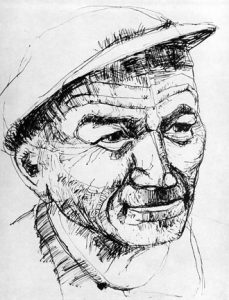
Jérôme Bazin has just completed his doctoral thesis on painting and the graphic arts in the German Democratic Republic from 1949 to 1990, which has been greeted as a quite new and quite complete study of a situation that remains problematic today. While, in present-day Germany, works produced in the past create a sense of discomfort, provoke a loss of interest, or induce nostalgia, they remain little known to us outside of Germany.
What is one to say about an “art without qualities” in this country where the production of images by professionals (the Union of artists) as well as by amateurs was encouraged? What was the place of equality in a world where the very status of the artist comes under the heading of a caste privilege? Are there no bridges between East and West, be it only through the existence of an art market governed by some surprising rules?
Jérôme Bazin begins to respond here to these questions, his answers being based on the consultation of several different types of archives but also and especially on the works themselves.
Laurence Bertrand Dorléac
'The Same Wage and the Same Ration, from the Worker to the Minister':
Art and Equality in the German Democratic Republic
Jérôme Bazin
Artistic production in the people’s democracies continues to pose a problem today. In present-day Germany, for example, works executed during the GDR era most often create a sense of discomfort and provoke a loss of interest, or, conversely, induce nostalgia. And the incessantly repeated desire to produce a neutral discourse about them never succeeds in being satisfied. In the face of such embarrassment, different solutions have been proposed. One of them consists in folding the images back onto the ideology of State Socialism and seeing in them mere illustrations of political messages (which, to tell the truth, most often boils down to not seeing them at all). Another solution consists in examining only the margins of the Socialist art world, hoping to find therein some images that would have avoided the grip of Socialism and that would offer similarities with works done in the West. In both cases, the immense majority of artistic production (portraits of workers, work scenes, industrial landscapes, and historical episodes) remains in the shadows and is seen as a negligible quantity.
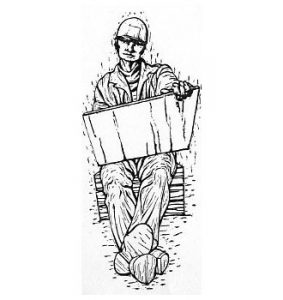
Günter Blendinger, Zeichnender Bauarbeiter, 1968, linocut, 21×68 cm.
The large number of images in fact constitutes part of the problem, the Eastern countries having produced an extraordinary quantity of paintings, drawings, and engravings. The East German regime never stopped encouraging both professionals (that is to say, those belonging to the artist’s union) and amateurs to make images. In the GDR, the amateur movement was positioned within the context of what was called the “Bitterfeld Path.” Launched in 1959 in the specific context of the struggle against “revisionism,” the Bitterfeld Path had lasting effects on the world of East German art. Indeed, the number of amateurs passed from 15,000 in the 1950s to 40,000 in the 1980s for a population that went from 18.3 to 16.7 million inhabitants between those two dates (as for the number of painters, illustrators, and engravers, it remained stable at around 1,500 people). The social composition of the circles of amateurs varied from one place to another, but all social groups participated, even among those with the most modest of incomes and backgrounds. The industrial city of Bitterfeld was chosen as the point of departure for this movement, for it had been, since the late nineteenth century, one of Germany’s red bastions, dominated by a working-class world that was self-confident and filled with a genuine passion for equality. It was here, for example, that a worker, a former member of the KPD, left the party in 1950 when he noted that inequalities had persisted within the framework of Socialism. In order to justify his departure, he wrote in favor of “the same wage and the same ration, from the worker to the minister.”
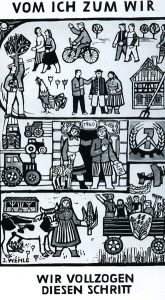
Ingeborg Wehle, Vom Ich zum Wir, 1960, wood engraving, 46×26,5 cm.
If one wants to comprehend the images born within this context, one must therefore draw near to this art without quality. Around it, original social configurations were invented, ones that were very far removed from the worlds of avant-garde, neo-avant-garde, and post-avant-garde art movements. One must also summon a variety of sources: art criticism, political speeches, and writings by artists, to be sure, but also union and company archives, for unions and companies were placed in charge of the practice of art for all and by all. Working on art in the Eastern countries requires a back-and-forth movement between several types of archives and between several social worlds, so that one might account for one of the key dimensions of Socialist Realism: shattering the insularity of social worlds.
The Appearances of Equality
The alleged simplicity of the images is challenged when controversies surrounding formal issues appear in the archives. The functionaries and cadres who organized artistic activities were divided as to what formal orientation to follow and on the choice of which images were to be rewarded. When, in 1960, the union awarded an artistic prize to the wood engraving From I to We, numerous amateurs, professionals, and functionaries wrote to the central leadership of the union to complain that such a type of art had been awarded a prize.[ref]Bundesarchiv Stiftung Archiv der Parteien und Masseorganisationen der DDR (BArch SAPMO), FDGB Bundesvorstand (DY 34), no. 6964.[/ref]
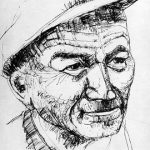
Rudi Kail, Mauerporträt, 1967, India ink drawing, 41×28 cm.
The perimeter of authorized forms for professionals and amateurs continued to expand from 1949 to 1989. The beginning of this period was marked by Zhdanovism, the strict regulation of acceptable and unacceptable forms with which the name Socialist Realism remains most of the time associated. Beginning in the 1950s, the system of censorship started to come undone; the terms Realism and Socialism continued to be used to describe images, but they were less frequently attached to each other. Nevertheless, despite the new possibilities that were opening up at the time, an attachment to Realism on the part of numerous artists could be noted. East German Realism thus demonstrated an astonishing capacity to tame and subdue the classic avant-garde movements of the first half of the twentieth century so as to bend them to its modest dimensions.
A wood engraving executed by a mechanic from Karl-Marx-Stadt (today Chemnitz) on the occasion of the death of Salvador Allende in September 1973 was presented as an improvement on the Die Brücke group of artists.
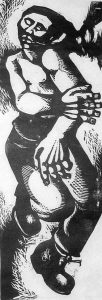
Lothar Kittelmann, Chile 73, 1973, wood engraving, 64×22 cm.
The engraving adopted and, at the same time, polished up the angular face, the empty eyes, and the large hands found in the art of Karl Schmidt-Rottluff, who at this date had already been fully rehabilitated in the GDR.
The Visualization of Hierarchies in a Socialist Society
The issue of equality was also played out in the image one gave of the social body and its divisions. In 1970, for example, the Bitterfeld electrochemical factory commissioned its circle of amateurs to create a cycle of works devoted to the “pioneers of the firm.” Each person represented can be identified: managerial personnel, engineers, employees, and production workers. The fourth plate shows a production worker (recognizable by the protective mask he is holding in his hand) and an engineer from the construction office who is carrying a drawing board in her arms. The entire cycle was presented to the firm’s 25,000 wage earners during its annual festival (Betriebsfestspiel) in 1970.
Now, social-history studies have shown that, in the factories of Bitterfeld as in most GDR firms, distances between groups remained sizeable. Mutual feelings of mistrust drove groups away from each other. Workers appeared to management and the engineers as a mass of inferiors who had to be “led” with firmness, whereas the base considered “those up above” to be a vague collection of arrivistes and opportunists who had gotten out of doing the hard and dirty work of actual production. The Socialist context thus changed little in the framework that had been inherited from class society, even though it did bring about a few notable alterations (for example, in the 1960s, women began to obtain positions of responsibility as well as engineering jobs previously reserved for the men). Class identities were anchored in everyday experiences and in people’s bodies (in 1968, an accident at the Bitterfeld factory left 40 dead and 260 injured among the production workers).
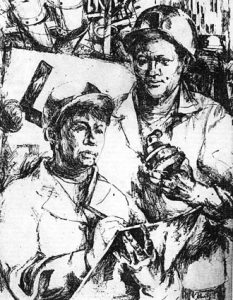
Cercle d’amateurs de Bitterfeld, Schrittmacher unseres Kombinattes. Blatt 4, 1970, drawing.
The archives of the firm and the union leave little space for wage earners to speak out and provide no indications about their reactions to the 1970 cycle. But the actual execution of the drawings by amateurs from the factory turns out to provide a wealth of information. One can detect in the image no conflict or tension among the wage earners, who are smiling and concentrated on their work. Social boundaries appear only through the juxtaposition of figures. On the fourth plate, a simple stroke draws the collar line (Kragenlinie) separating blue collars from white collars. The cycle is emblematic of the way in which social differences operated within a Socialist society: such differences were omnipresent and at the center of people’s attention, but the conflicts contained therein could not be expressed (strikes, still frequent in the 1950s, disappeared later on, and starting in 1968 the right to strike was no longer recognized).
Orthodoxy offered a framework for both explaining and justifying the Socialist order. Between the capitalist period (marked by conflict between classes separated by antagonistic interests) and the Communist period to come (to be made up of effectively equal individuals) was situated the transitional period. This was the Socialist period, which was to make two social classes (peasants and workers) coexist with a social stratum, the Intelligenz, that was supposed to be working in the interests of the two dominant classes. Orthodoxy invented the fiction of an antagonism without any hatred, and the 1970 cycle offers a fragile image of this.
Economy and Equality
The archives provide quite a great wealth of information about the economic circulation of images. In the East, there really was a trade in art. The extent of such trade is surprising, and this trade was itself extensively regulated. “Directives on honoraria” set minimum and maximum prices. This pricing scale (regularly revised in 1952, 1971, 1978, and 1980) was a key element for the definition of egalitarian art: the most modest art products had to be sold at a decent price, while the most prestigious ones were not to go beyond a certain threshold. It is surprising to note in various sources[ref]Sources relating to pricing negotiations and concerning directives are found in the archives of the artists’ union (Archiv Akademie der Künste in Berlin, Verband Bildender Künstler Zentralvorstand), in the artists’ fund (Sächsisches Landes- und Universitätsbibliothek Dresden), and also in the archives of business firms (the factory archives of Eisenhüttenstadt offers, for example, several examples: see the Archiv VEB Bandstahlkombinat Hermann Matern Eisenhüttenstadtkombinat EKO).
[/ref] that all those involved—from the most well-known professional artists to the most anonymous amateurs—made reference to this pricing scale and scrupulously respected it. Amateur artists were in fact full participants in the Socialist art trade; the few attempts to make amateur art a noncommercial activity, outside of the economy, were quickly swept away and, in the view of most of those involved, the effort to put amateurs on an equal footing with professionals was, in the view of most, to be achieved through their participation in the economic process.
Conclusion: modesty and Violence
The issue of equality in the Socialist countries is consequently not summed up by a belief in an equality to come later on. It was posed much more broadly in people’s everyday practices and experiences. The world of amateurs in relation to the world of professionals offers a privileged laboratory for grasping the various ways in which this issue was raised in the field of art. Revising our views on the issue of equality may, moreover, allow us to understand better the kind of art that was being done at the margins but that was not recognized, particularly the StandArt of A.R. Penck in the years 1970-1972, which was imbued with the egalitarian rhetoric of the Socialist regime, or the various revivals of Constructivism in the GDR. It is apparent today that nonofficial art is found to be terribly impoverished if it is analyzed solely in terms of resistance to power (many nonofficial artists were, indeed, well disposed toward the Socialist regime, which nonetheless did not recognize their art and marginalized them).
Official Realist images manifested a cowardly kind of solidarity with State Socialism by playing two sometimes complementary, sometimes contradictory roles that had been assigned to Socialist Realism: serving the regime and promoting the popular strata. The issue of equality thus allows us to shed new light on the exercise of politics within the peculiar context of Socialist dictatorship. Such a politics is not to be reduced just to bringing artists to heel (Gleichschaltung) as it also included a broad range of egalitarian practices (Gleichheit), these being two phenomena that need to be considered at the same time. We must be sensitive to the violence that lies behind countless portrayals of smiling workers and peaceful work scenes. Realism was carried forth by the elevation of the inferior and by the violence of the movement through which the popular world was given, and sometimes gave itself, a sense of dignity.
Selected Bibliography
BARCK, Simone and Stefanie WAHL. Ed. Bitterfelder Nachlese. Ein Kulturpalast, seine Konferenzen und Wirkungen. Berlin: Dietz, 2007.
BITTNER, Regina. Kolonien des Eigensinns. Ethnographie einer ostdeutschen Industrieregion. Frankfurt am Main: Campus, 1998.
BONNKE, Manuela. Kunst in Produktion. Bildende Kunst und volkseigene Wirtschaft in der SBZ/DDR. Cologne: Böhla, 2007.
HELD, Jutta. “Arbeit als künstlerisches Motiv—Theoretische und bildliche Modelle aus der DDR. Eine historische Skizze.” Kunst und Politik, 7 (2005): 17-39.
HELD, Jutta. “Die Aktualität des Bitterfelder Weges.” In Annette Tietenberg. Ed. Das Kunstwerk als Geschichtsdokument. Munich: Klinkhardt und Biermann, 1999: 210-18.
KIAER, Christina. “Was Socialist Realism Forced Labour? The Case of Aleksander Deineka in the 1930s.” Oxford Art Journal, 28:3 (2005): 321-45.
KLESSMANN, Christoph. Arbeiter im “Arbeiterstaat” DDR. Deutsche Traditionen, sowjetisches Modell, westdeutsches Magnetfeld (1945 bis 1971). Bonn: Dietz, 2007.
KOTT, Sandrine. “Zur Geschichte des kulturellen Lebens in DDR-Betrieben. Konzepte und Praxis der betrieblichen Kulturarbeit.” Archiv für Sozialgeschichte, 39 (1999): 167-95.
LÜTDKE, Alf. “Helden der Arbeit—Mühen beim Arbeiten. Zur missmutigen Loyalität von Industriearbeitern in der DDR.” In Hartmut Kaelble, Jürgen Kocka, and Hartmut Zwahr. Ed. Sozialgeschichte der DDR. Stuttgart: Klett-Cotta, 1994: 188-213.
OLBRICH, Harald. Proletarische Kunst im Werden. East Berlin: Dietz, 1986.
REID, Susan E. “Socialist Realism in the Stalinist Terror: The Industry of Socialism Art Exhibition, 1935-1941.” Russian Review, 60:2 (2001): 153-84.
WAGNER-KYORA, Georg. Vom “nationalen” zum “sozialistischen” Selbst: zur Erfahrungsgeschichte deutscher Chemiker und Ingenieure im 20. Jahrhundert. Stuttgart: Steiner, 2009.
Jérôme Bazin is a doctoral student in history and art history at the university of Geneva and the University of Amiens. His work bears on the social history of painting and the graphic arts in the GDR from 1949 to 1990. He also participates in the program jointly organized by the Marc Bloch Center of Berlin and the University of Poznan on the geography of art in Communist Europe (http://art-communism.eu). bazin.jerome@wanadoo.fr
